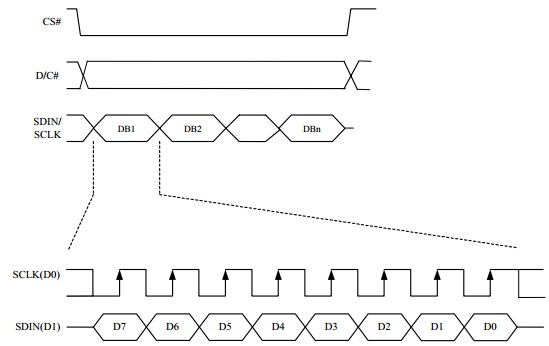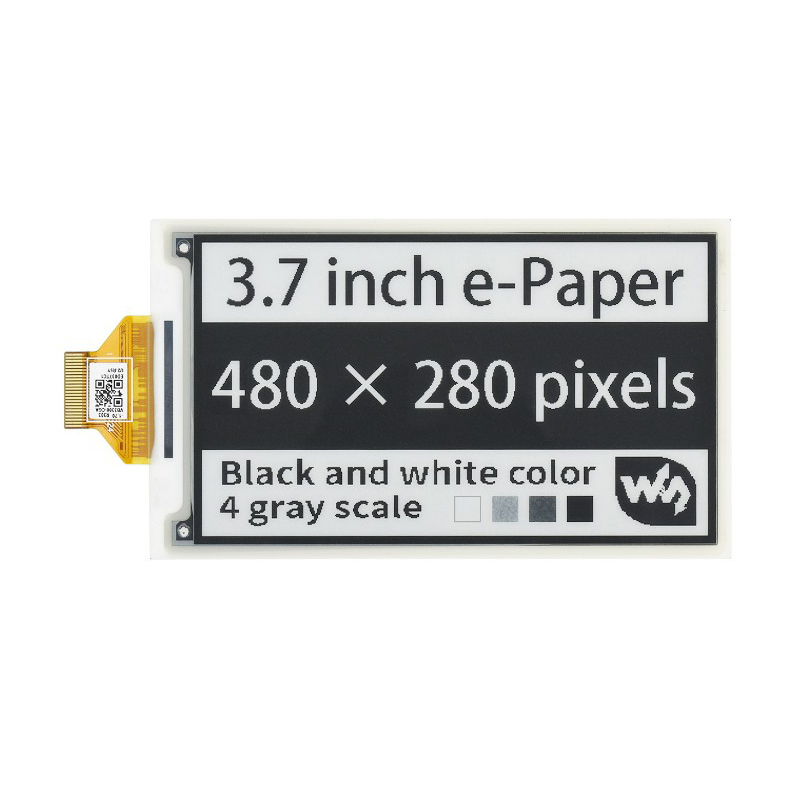- sales/support
Google Chat: zj734465502@gmail.com
- sales
+86-0755-88291180
- sales01
sales@spotpear.com
- sales02
dragon_manager@163.com
- support
tech-support@spotpear.com
- CEO-Complaints
zhoujie@spotpear.com
- sales/support
WhatsApp:13246739196
- HOME
- >
- ARTICLES
- >
- Common Moudle
- >
- LCD
3.7inch e-Paper
Introduction
Note: The raw panel requires a driver board, If you are the first time use this e-Paper, we recommend you to buy the HAT version or buy more one driver hat for easy use, otherwise you need to make the driver board yourself. And this instruction is based on the HAT version.
480x280, 3.7inch E-Ink display HAT for Raspberry Pi, SPI interface
Interfaces
| VCC | 3.3V |
| GND | GND |
| DIN | SPI MOSI |
| CLK | SPI SCK |
| CS | SPI chip select (Low active) |
| DC | Data/Command control pin (High for data, and low for command) |
| RST | External reset pin (Low for reset) |
| BUSY | Busy state output pin (Low for busy) |
SPI timing
This product is an E-paper device adopting the image display technology of Microencapsulated Electrophoretic Display, MED. The initial approach is to create tiny spheres, in which the charged color pigments are suspending in the transparent oil and would move depending on the electronic charge. The E-paper screen display patterns by reflecting the ambient light, so it has no background light requirement. Under ambient light, the E-paper screen still has high visibility with a wide viewing angle of 180 degrees. It is the ideal choice for E-reading. (Note that the e-Paper cannot support updating directly under sunlight)
- Communication protocol
Note: Different from the traditional SPI protocol, the data line from the slave to the master is hidden since the device only has a display requirement.
- CS is the slave chip select. When CS is low, the chip is enabled.
- DC is data/command control pin, when DC = 0, write command, when DC = 1, write data.
- SCLK is the SPI communication clock.
- SDIN is the data line from the master to the slave in SPI communication.
SPI communication has data transfer timing, which is combined with CPHA and CPOL.
- CPOL determines the level of the serial synchronous clock at idle state. When CPOL = 0, the level is Low. However, CPOL has little effect to the transmission.
- CPHA determines data is collected at the first clock edge or at the second clock edge of the serial synchronous clock; when CPHL = 0, data is collected at the first clock edge.
- There are 4 SPI communication modes. SPI0 is commonly used, in which CPHL = 0, CPOL = 0.
As you can see from the figure above, data transmission starts at the first falling edge of SCLK, and 8 bits of data are transferred in one clock cycle. Here, SPI0 is in used, and data is transferred by bits, MSB first.
Working protocoal
Pixel & Byte
We define the pixels in a monochrome picture, 0 is black and 1 is white.
White:□,Bit 1
Black:■:Bit 0
- The dot in the figure is called a pixel. As we know, 1 and 0 are used to define the color, therefore we can use one bit to define the color of one pixel, and 1 byte = 8pixels
- For example, If we set first 8 pixels to black and the last 8 pixels to white, we show it by codes, they will be 16 bit as below:

For computer, the data is saved in MSB format:
So we can use two bytes for 16 pixels.
- In addition to bicolor displaying, the 3.7inch e-Paper also supports four grayscale.
- To display grey pixels, we need to define data for gray
- Black: 00b
- Dark Grey: 10b
- Light Grey: 01b
- White: 11b
| Pixel | 1 | 2 | 3 | 4 | 5 | 6 | 7 | 8 | ||||||||
| Bit | 7 | 6 | 5 | 4 | 3 | 2 | 1 | 0 | 7 | 6 | 5 | 4 | 3 | 2 | 1 | 0 |
| Data | 0 | 0 | 0 | 0 | 1 | 0 | 1 | 0 | 0 | 1 | 0 | 1 | 1 | 1 | 1 | 1 |
| Color | Black | Black | Dark Grey | Dark Grey | Light Grey | Light Grey | White | White | ||||||||
| Byte | 0x0A | 0x5F | ||||||||||||||
The display divides a four-grayscale picture into two pictures. The pixels in the same position of pictures are combined into one pixel.
| Register | White | Light Grey | Dark Grey | Black |
| 0x24 | 0x01 | 0x00 | 0x01 | 0x00 |
| 0x26 | 0x01 | 0x01 | 0x00 | 0x00 |
With the tables above, you can define the data which can be used to display grayscale pixels in the 3.7inch e-Paper
| Pixel | 1 | 2 | 3 | 4 | 5 | 6 | 7 | 8 | ||||||||
| Bit | 7 | 6 | 5 | 4 | 3 | 2 | 1 | 0 | 7 | 6 | 5 | 4 | 3 | 2 | 1 | 0 |
| Data | 0 | 0 | 0 | 0 | 1 | 0 | 1 | 0 | 0 | 1 | 0 | 1 | 1 | 1 | 1 | 1 |
| Color | Black | Black | Dark Grey | Dark Grey | Light Grey | Light Grey | White | White | ||||||||
| Byte | 0x0A | 0x5F | ||||||||||||||
| Bit in 0x24 register | 0 | 0 | 1 | 1 | 0 | 0 | 1 | 1 | ||||||||
| Bit in 0x26 register | 0 | 0 | 0 | 0 | 1 | 1 | 1 | 1 | ||||||||
| Data sent to 0x24 register | 0x33 | |||||||||||||||
| Data sent to 0x26 register | 0x0F | |||||||||||||||






